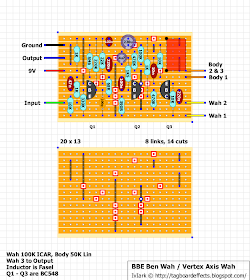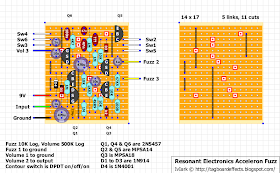We always recommend trying the boards out before soldering everything in to the enclosure. Main reason being that if you have an error on your build, it's about a hundred times harder to find it inside the otherwise finished build. Like
Madbean says - Build it, Rock it, Box it. There is a reason for that order. One could, of course, simply use a breadboard and/or simple screw terminals to achieve the same goal, but if you are building more than one circuit every now and then.. Well. Then i'd suggest you'd build yourself a test box. I've had a few different methods of trying the boards out before boxing, but my latest, equipped with a little more sophisticated screw terminal block was closing in on the end of the road. It was simply falling apart due all the use it had seen. So. I wanted to build myself a new one with slightly more features than the previous one. And while i was at it, i snapped a few (poor) shots of the process. A slight warning: This "photo essay" may not be detailed enough for someone who's doing anything like this for the first time. But if you know what you're doing, you're more than welcome to try something similar out. Here's my "Test box 2.0", which includes a switchable audio probe input. Let's start out with what you'll need.

Most things needed are your standard pedal parts.
- Enclosure (i used a plastic box that can be found through Tayda)
- 4-way speaker terminal and bolts/nuts for it (again, Tayda)
- 2 mono jacks
- Binding post for "banana" connector (mine isn't exactly like this, but once again - Tayda)
- 3PDT On-On toggle switch
- DPDT On-On toggle switch
- 1µ polyester box capacitor (higher the voltage rating, the better)
- Small piece of stripboard
- 2 LEDs (i used diffused red and orange)
- 2 1K2 resistors for the LEDs
- Holders for the LEDs
- A few meters of wire of your choice
- Heat shrink tube etc. etc.
I drilled the enclosure first and started with mounting all the ingredients. Due to location of everything on my bench, i went with jacks on the left, speaker terminals on the right, DC jack on top and probe binding post at the bottom. I Placed the switches on the upper half, because it just looked like that would be a good place for them. The LED holders are below the switches. You should probably think the geometry of all the parts so that it'll suit your needs and bench.
Next up, we'll wire the grounds. The DC jack pictured here has its longer leg as sleeve and shorter as tip, so we'll take a wire from the short one to lug 2 of the DPDT switch - and from that pin to the second speaker terminal lug - and from that to input jack's sleeve - and from that to output jack's sleeve - and from that to lugs 1, 4 and 5 of the 3PDT switch. Here's picture of all the grounds connected:
Now, the small piece of vero. We're using that as a tiny daughter board for our LED resistors, just to keep everything neat. 4x5 board is enough. We'll wire two red wires to one row with two resistors and one wire for each row that has the other end of the resistor. Those wires are for the LED anodes. Like so:
Now we can wire up all the "hot" leads inside the box. To attach the tiny board to the enclosure, i used Tesa PowerBond Outdoor branded two sided adhesive tape. 3M's similar product doesn't insulate the connections, so do not use that. With slightly bigger board one could use a plastic, or even metal PCB standoffs, but i've found the Tesa tape to be sufficient solution. LEDs go their respective holders (i'm using red for bypass/3PDT and orange for probe/DPDT) and cathodes need to be soldered to lug 3 of the DPDT and lug 6 of the 3PDT. The longer free red wire goes to DC jack's sleeve and the shorter to the first speaker terminal lug.
Now we have all the grounds and supply wires hooked up. Next we'll need to solder up the signal wires. Connections are pretty much per the standard outboard wiring, but please do read this twice to make sure you got it:
- Green wire - from 3PDT lug 2 to speaker terminal lug 4
- Blue wire - from speaker terminal lug 3 to 3PDT lug 9
- Yellow wire - from input jack's tip to 3PDT lugs 3 & 7
- Orange wire - from 3PDT lug 8 to DPDT lug 4
- Brown wire - from DPDT lug 5 to output jack's tip
All that wiring is depicted here:
We're pretty much all set, but the probe section is still missing. The box does work as it is now, but there's no use for the binding post and the DPDT switch does nothing - but light up the LED when set to probe mode. Now we'll need to solder two wires to the 1µ capacitor. Like this:
Other end of that wire is then fastened to the screw at the bottom of the binding post. The other end needs to be soldered to DPDT lug 6. I used a small piece of the two sided adhesive tape to keep the capacitor nicely in one place. Like so:
That's it. Simple and straight forward. The 3PDT bypass switch acts as a true bypass in the same manner as in any pedal. The speaker terminal connections are the ones where you'll snap in your just finished new effect board. One for supply voltage, one for ground, one for circuit input and one for circuit output. Here's a shot of the thing in action:

Some of you may think "why add the binding post for the probe?" Here's the reason - let's assume i've built a board, hooked it up to this box and it doesn't work. There's no signal passing through. We already have the ground wire for the circuit connected, so why should we rip out all the cables (excluding the supply/ground) and clamp an alligator clip to a ground point on circuit, plug the probe to the amp and start probing? For no reason. With this setup, we can simply connect a multimeter's test lead to the binding post, flick the probe switch and start probing. Even when debugging a broken factory pedal, this solution eliminates the need for a separate probe. Just connect that pedal's grounds to the ground slot of the speaker terminal and start probing.
How am i going to remember which of the speaker terminal slots is which and which jack is which? I'm probably not going to, so. I added some Dymo tape to mine...
I = Input, O = Output, G = Grounds and V = voltage in. Don't bother pointing out that the speaker terminal is upside down. It isn't. This way i can snap the wires in without having to lift the box off the table.
The idea for this box is rather simple and you should be able to add the features you want/need. Like for example - a negative charge pump and separate 2-way speaker terminal for the -9V and ground. That feature would enable you to try out positive ground circuits with the same test box. Why i'm not doing that? Because i have a lab supply on my bench and i want to be able to try the circuits out with higher voltages than just 9V. So ICL7660S with maximum input of 12V doesn't really suit my purpose.
One last thing. If you don't have a lab power supply with quick fuse, please do not test your circuits with a wall wart power supply. Even the slightest short will burn your supply or its regulator in a heartbeat. For testing purposes - solder a standard DC plug to a battery snap and go with that. You'll be able to drain a battery in ten seconds with a short, but it'll be a lot cheaper than burning wall socket adapters.
















































